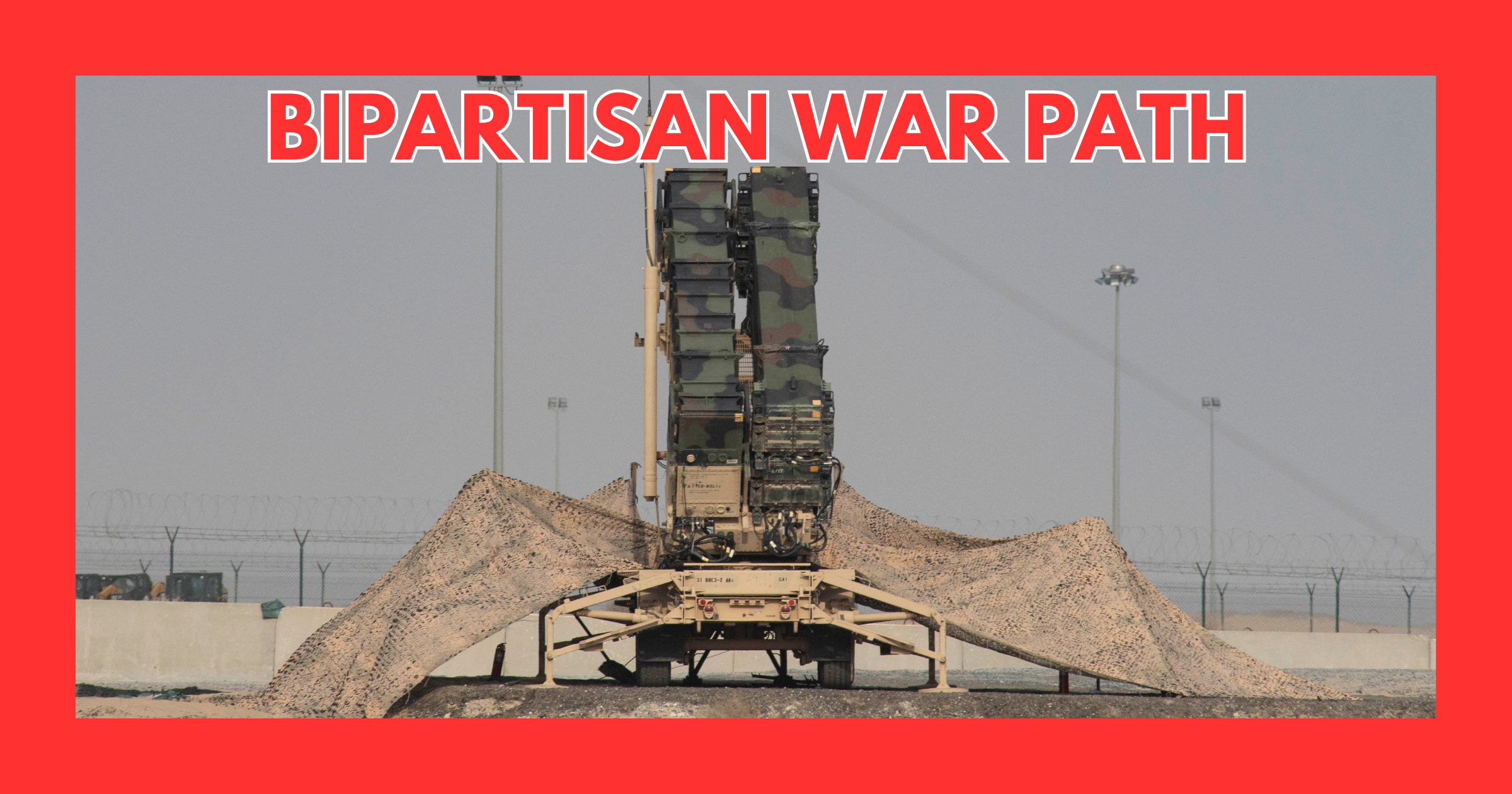
Photo by: SSgt Kenneth Boyton – CENTCOM
Bipartisan War Path: The Iran Strike Both Parties Have Already Endorsed
Partisan lines may run deep, but on retaliation against Iran, they’ve already been erased.
by Met Middleson
June 15, 2025
The conflict between Israel and Iran has entered a dangerous new phase. After Israeli warplanes struck deep into Iran, targeting nuclear sites, command centers, and senior IRGC officials, Iran responded with a wave of missile and drone attacks on Israeli cities. Now Tehran is signaling that U.S. forces could be next. With American troops spread across the region and both political parties in Washington already voicing support for a military response, the window for staying out of this war may already be closing.
THE FLASHPOINT MOMENT
Air raid sirens pierced the night in Tel Aviv as hundreds of drones and missiles filled the sky. Some were intercepted. Some landed. Fires burned across parts of central Israel, while inside Iran, the fallout from Israeli airstrikes had already left hundreds dead, including senior military officials, nuclear scientists, and civilians. The scale of the exchange on both sides was unlike anything seen in decades.
What began with the opening wave of an Israeli campaign targeting Iran’s missile and nuclear infrastructure has now spiraled into a regionwide emergency. Iran’s retaliatory strike, called Operation True Promise III, launched over 150 ballistic missiles and more than 100 drones toward Israeli cities.
By the end of the first wave, Iran had suffered over 400 deaths and more than 650 injuries from Israeli strikes. Tehran’s response left at least 14 Israelis dead and nearly 400 injured. With Iranian officials now threatening to expand retaliation beyond Israel, U.S. forces may be next.
For the first time since the height of the Soleimani crisis in 2020, American military personnel stationed across the Middle East are facing direct and open threats from Iran. And this time, the warnings from Washington are not just coming from one party or one branch of government. They are coming from across the aisle and they are coming fast.
TARGETS WITHIN RANGE
The United States has thousands of troops positioned across the Middle East, many of them stationed within reach of Iranian drones, missiles, or proxy militias. From airfields in Iraq to naval assets in the Red Sea, these personnel now face a heightened threat that Iran has publicly acknowledged.
Among the most likely targets are U.S. bases in Iraq, Syria, and Jordan, where troops support counterterrorism missions and regional stability operations. The al-Tanf garrison in Syria sits in a strategic corridor connecting Iranian forces in Iraq to Hezbollah fighters in Lebanon. It has been targeted by drone swarms before, and military officials say it remains one of the most vulnerable forward operating positions in the region.
Further east, U.S. installations in Kuwait, Qatar, and Bahrain host command centers, interceptor batteries, and logistics hubs. These bases are equipped with advanced missile defense systems, but their visibility makes them symbolic targets. In recent months, Iranian-backed Houthi forces in Yemen have launched drones that reached as far as Eilat in southern Israel, demonstrating expanded range and growing capability.
At sea, American naval groups operating in the Persian Gulf and Red Sea face threats from drones and ballistic missiles launched from Iran or its proxies. The USS Dwight D. Eisenhower carrier group has been conducting defensive operations and joint patrols in the region. If Iran views U.S. naval activity as interference in its response to Israel, these assets could be drawn into direct conflict.
Iran does not need to launch a formal war to hit American targets. It has already spent years training, funding, and supplying regional militias capable of doing it for them. The question now is not whether U.S. forces are within range. It is whether Tehran is ready to cross that line.
WAR PREPARATIONS UNDERWAY
The rhetoric is escalating, and so is readiness. As threats from Tehran become more explicit, the United States is preparing in earnest, readying defenses and adjusting posture in response.
Defense Secretary Pete Hegseth confirmed this week that the Pentagon rerouted anti-drone equipment from Ukraine to the Middle East. Among the systems moved were proximity-fuzed interceptors and counter-drone munitions originally intended to support Ukrainian air defense. When asked about the decision in a Senate hearing, Hegseth was blunt: “Yes we did.” His reasoning was just as direct: “The Middle East remains a very dynamic theater … we will deploy counter-drone systems to our troops and bases whenever there is a threat.”
Iranian state media and Islamic Revolutionary Guard Corps–linked channels have issued public warnings of “direct consequences” if U.S., British, or French forces assist Israel in intercepting Iranian missile or drone attacks. With U.S. forces already stationed across the region and contributing intelligence and defensive support, those warnings are not being taken lightly.
In response, the U.S. has begun evacuating non-essential personnel from select embassies and consulates, including Baghdad and Bahrain. Family members of service members and diplomats have been placed under travel restrictions or flown out. Meanwhile, the Pentagon has repositioned destroyers and missile defense assets closer to Israel and the Eastern Mediterranean, reinforcing intercept capabilities should American forces or allies come under attack.
These are not precautionary drills. They are active defensive moves meant to protect American lives and interests. The drivers are clear: escalating threats from Iran and a real possibility of U.S. involvement if American forces are hit.
Even voices urging restraint acknowledge the danger. On Face the Nation, Senator Richard Blumenthal said he supports diplomatic efforts to prevent escalation but made clear that “paramount among our goals now must be to protect U.S. personnel in the region.” Senator Lindsey Graham, speaking just moments later, was far more direct: “If there is one attack on an American anywhere in the Middle East by Iran, then you’ll get regime change.”
These are not speculative threats. They are political signals matched by military moves. And taken together, they suggest a nation not yet at war, but already moving to fight one.
BIPARTISAN SIGNALS
When it comes to foreign policy, especially war, American politics rarely speaks with one voice. But on this issue, the message has been unusually clear. If Iran targets American troops, there will be a response, and it will be forceful.
President Donald Trump, who has distanced himself from the Israeli strike itself, issued an unambiguous warning on Truth Social: “If Iran attacks any U.S. forces or assets, we will respond with full force and might. I hope they are smart enough not to try.” While emphasizing that the United States was not involved in the initial operation, his message made clear that any Iranian action against U.S. personnel would trigger a direct and forceful response.
That message was echoed by one of his frequent critics. Appearing on Meet the Press, Representative Adam Schiff stated, “If Iran retaliates against U.S. forces or assets, we will respond. And that response will be forceful.” Schiff had no interest in drawing distinctions. He supported diplomacy where possible but backed military response as necessary.
Senator Richard Blumenthal, speaking the same day on Face the Nation, offered a more measured but no less clear position. While urging diplomacy to prevent escalation, he emphasized that “paramount among our goals now must be to protect U.S. personnel in the region.”
And then came Senator Lindsey Graham, offering the bluntest warning yet. “If there is one attack on an American anywhere in the Middle East by Iran, then you’ll get regime change.” His statement was presented not as personal opinion, but as a direct warning of what the U.S. response could be.
Together, these statements span the ideological spectrum and speak to a rare convergence. This is not just rhetoric from hawks or threats from one side of the aisle. It is a growing political consensus that retaliation is not just permitted. It is expected.
WHEN RESTRAINT HELD THE LINE
This is not the first time the United States has faced the threat of open conflict with Iran. And in past flashpoints, the decision to hold back has often been made under intense pressure. What makes this moment different is not just the scale of the violence between Israel and Iran. It is how unified Washington appears in signaling a willingness to strike back.
In January 2020, after a U.S. drone strike killed Iranian General Qassem Soleimani in Baghdad, Iran responded with a barrage of ballistic missiles targeting American troops at Al Asad Airbase in Iraq. While more than 100 U.S. service members suffered traumatic brain injuries, no one was killed. President Trump, then in office during his first term, chose not to escalate further. The two countries stepped back from the brink, aided by intermediaries and strategic ambiguity.
Earlier, between 2007 and 2011, Iran-backed militias in Iraq carried out deadly attacks on U.S. troops using explosively formed penetrators and rocket fire. Those strikes killed hundreds of Americans but were not met with direct strikes on Iran itself. The prevailing strategy focused on containment and indirect responses, avoiding open war even as casualties mounted.
In those moments, restraint was not passive. It was a deliberate choice rooted in the belief that a wider war could be avoided even in the face of provocation. The goal was to deter further aggression without triggering a conflict that could spiral across the region.
Today’s posture appears different. Key lawmakers are not just calling for readiness. They are framing retaliation as inevitable. Intelligence sharing and air defense coordination with Israel continue, while Iran publicly threatens American bases if they assist. Each side now speaks in clear terms, and the gray zones that once gave leaders political room to maneuver are shrinking fast.
THE ESCALATION PATH
The shift is not just rhetorical. It is operational. What was once a red line—direct attacks on U.S. personnel—is now being treated as a likely trigger for a broader war. And the groundwork for that response is already being laid.
The United States has deployed additional naval assets to the Eastern Mediterranean. Fighter squadrons have been repositioned to forward bases in Qatar and the UAE. Intelligence coordination with Israel has accelerated, and air defense systems across the region are being calibrated for layered coverage. None of these movements are being described as offensive. But they all signal readiness.
Iran, meanwhile, continues to posture. IRGC commanders have warned of “multi-axis retaliation” if the conflict spreads. State-run media has aired footage of long-range missile units on alert, and proxy militias across Iraq and Syria have reportedly received new targeting guidance for U.S. and allied positions. The threat environment is no longer theoretical. It is active and evolving.
At home, the American public is only beginning to tune in. With Congress out of session and the presidential campaign in full swing, there is no formal debate underway. But the positions are already staked out. Leading voices in both parties have backed the right to retaliate if American troops are attacked. The window for diplomacy is shrinking, and momentum may overtake deliberation.
MET-aphorically Speaking
The grenade may not have been thrown, but the pin is already out. The tension is real and the clock is ticking. What comes next may not start the war outright, but it will set a course that is hard to reverse. Retaliation, once set in motion, rarely stops at one blast.



